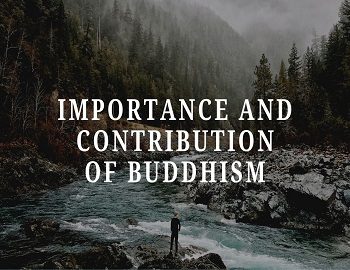Importance and Contribution of Buddhism:
The legacy of Buddhism was of much significance not only for India but for the whole world. It influenced the political, religious, social and cultural aspects of India in various significant ways-
(1) The new agriculture, trade and the advent of coins naturally enabled both rulers and traders to accumulate wealth and gave rise to economic inequalities. So Buddhism asked people not to accumulate wealth.
(2) The code of conduct prescribed for the monks represents a reaction against the material conditions of North-East India in the 6th century B.C. The code imposed restrictions on the dress, food, housing and sexual behaviour of the monks. Rules prescribing the clothing of monks reflect some kind of protest against the possibilities of using new varieties of textiles and leather goods which naturally would be considered luxurious in the context of the early iron age, but they do not imply the rejection of all clothing.
(3) With its emphasis on non-violence and the sanctity of animal life, Buddhism boosted the cattle wealth of the country. This teaching came significantly at a time when the Non-Aryans slaughtered animals for food, and the Aryans in the name of religion. The Brahmanical insistence on the sacredness of the cow and non-violence was apparently derived from Buddhist teaching.
(4) Under influence of the Buddhist doctrines of ahimsa and peace, the rulers started taking interest in internal administration and public welfare activities. Consequently, peace and order were established and there was a growth in prosperity.
(5) Since Buddhist teachings were propagated by puritan monks they made a greater impact on the common people. The day-to-day puritan conduct of the monks certainly appealed to lay followers, who could easily see the sharp contrast between it and the greedy life of the Brahmanas. So, although the code of conduct prescribed for the monks was different from that meant for laymen, the two together basically served the same purpose, the stabilization and promotion of new elements in the material life of people in middle Gangetic plains during the 6th and 5th centuries B.C.
(6) As a result of this religion, the importance of high moral values increased thus elevating the mental level of the masses.
(7) The bonds of casteism started weakening because of Buddha’s preachings of equality and tolerance.
(8) The womenfolk and the Sudras got an opportunity for living honourably under the influence of this religion.
(9) The Buddhist scholars, propagators, monks and nuns contributed greatly to the creation and development of popular literature.
(10) Promotion of education through residential universities like those at Taxila, Nagarjunakonda, Nalanda and Vikramsila.
(11) The language of Pali and other local languages developed through the teachings of Buddhism.
(12) The finest contribution of Buddhism to Indian life was made in the realm of architecture and sculpture. Buddhist architecture developed essentially in three forms- Stupa, Chaitya and Vihara. The Stupa is a domical structure in which the relics of the Buddha or some prominent Buddhist monk are preserved. Chaitya is a temple or shrine with a prayer hall. A Vihara is a monastery or residence of monks. The Stupas at Sanchi, Bharhut and Amravati, the stone pillars of Asoka and the cave temples of Kanheri (Bombay), Karle (Pune) and Nasik are considered the best specimens of Buddhist art. The Stupa at Sanchi is world-renowned for its gateways, and railing which are profusely covered with sculpture.
(13) The most important fact is that Buddhism proved to be one of the greatest civilising forces which India gave to the neighbouring countries. Buddhism broke the isolation of India and established intimate contact between India and foreign countries. It was India’s greatest gift to the outer world. Indian culture and civilization were carried by the Buddhist missionaries into China, Mongolia, Manchuria, Korea, Japan, Sumatra, Java, Burma and other countries from the time of Asoka.









Comments (No)